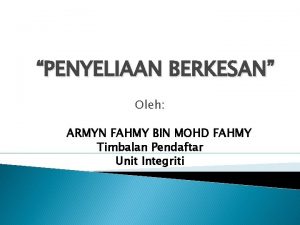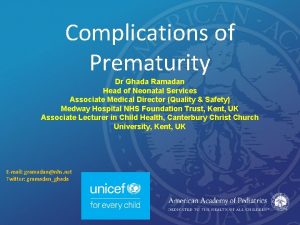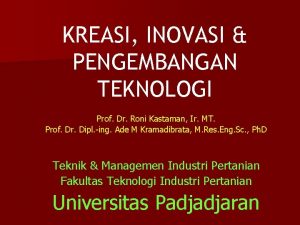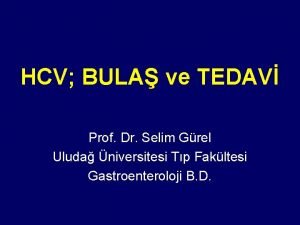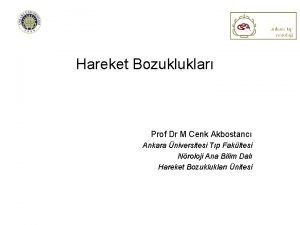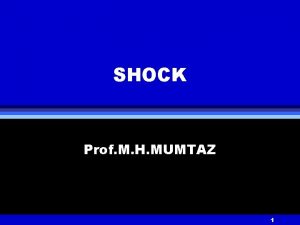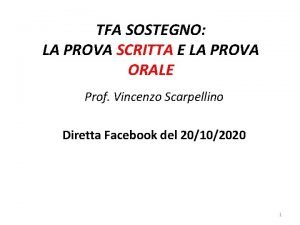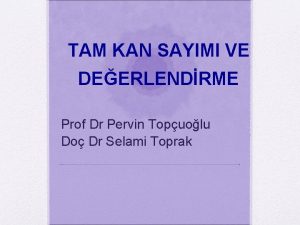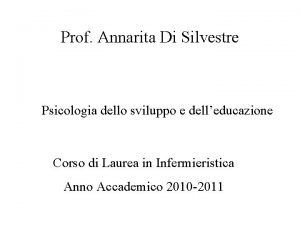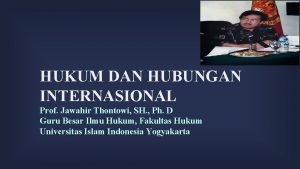Prof Dr Ghada Fahmy Helaly Prof Dr Ghada





![Neonatal meningitis/Streptococcus agalactiae (Group B streptococcus [GBS]). Beta-hemolytic, Gram-positive cocci in chains. Vaginal and Neonatal meningitis/Streptococcus agalactiae (Group B streptococcus [GBS]). Beta-hemolytic, Gram-positive cocci in chains. Vaginal and](https://slidetodoc.com/presentation_image_h2/418237460f16c7db7c9c285273987d81/image-6.jpg)












- Slides: 18

Prof. Dr. Ghada Fahmy Helaly

Prof. Dr. Ghada Fahmy Helaly BACTERIAL MENINGITIS Prof. Dr. Ghada Fahmy Helaly Microbiology Department Faculty of Medicine Mu’tah University NS 1 Module

Ø Meningitis : inflammation of the protective membranes covering the brain and spinal cord known as the meninges. ØThe inflammation is usually caused by an infection of CSF. ØThe most common are Viral meningitis, followed by bacterial and, rarely, fungal infections. , but meningitis can also be caused by physical injury, cancer or certain drugs. Prof. Dr. Ghada Fahmy Helaly

Bacterial meningitis: Ø Either community or hospital acquired. Identifying the cause is essential. Ø Acute meningitis (<1 d), chronic meningitis (weeks to months). ØBacteria can directly invade the meninges ( ear or sinus infection, a skull fracture, or, rarely, after some surgeries). Ø Serious complications, such as brain damage, hearing loss, or learning disabilities. ØTreatment must be started quickly. Untreated mortality rate of 50%. Prof. Dr. Ghada Fahmy Helaly

Prof. Dr. Ghada Fahmy Helaly Common causes of bacterial meningitis by age group: Age Group Causes Newborns: Birth to 3 months Group B Streptococcus, S. pneumoniae, E. coli, Listeria monocytogenes Infants and Children: 3 -60 months S. pneumoniae, Neisseria meningitidis, H. influenzae type b, Group B Streptococcus Adolescents and Young Adults Most common: S. pneumoniae, Others: N. meningitidis, L. monocytogenes Other G- organisms S. pneumoniae S. aureus* L. monocytogenes Gram-negative bacteria The elderly
![Neonatal meningitisStreptococcus agalactiae Group B streptococcus GBS Betahemolytic Grampositive cocci in chains Vaginal and Neonatal meningitis/Streptococcus agalactiae (Group B streptococcus [GBS]). Beta-hemolytic, Gram-positive cocci in chains. Vaginal and](https://slidetodoc.com/presentation_image_h2/418237460f16c7db7c9c285273987d81/image-6.jpg)
Neonatal meningitis/Streptococcus agalactiae (Group B streptococcus [GBS]). Beta-hemolytic, Gram-positive cocci in chains. Vaginal and oral flora in adult women (15 - 40% of women). Vaginal colonization respiratory infections and septicemia meningitis in newborns. Prolonged labor after the rupture of the membranes ↑ transmission risk. DISEASE: 1. Early-onset GBS neonatal sepsis (birth to 7 days) respiratory distress reduced by intra-partum antibiotics. 2. Late-onset neonatal sepsis (7 ds to 4 ms) meningitis. PROF. DR. GHADA FAHMY HELALY

Neonatal meningitis/E. coli. • This disease is caused by birth exposure to encapsulated (primarily K 1) strains of E. coli. K 1 antigen (polysaccharide) prevents the phagocytosis, ↑ adhesion. 1. Lactose-fermenting, member of the Enterobacteriaceae 2. Colonic normal flora (NF) (nonpathogenic strains) 3. May colonize lower end of urethra and vagina neonatal sepsis, meningitis PROF. DR. GHADA FAHMY HELALY

Neonatal meningitis or meningitis in compromised persons Listeria monocytogenes. 1. Beta-hemolytic, Gram-positive, facultative intracellular coccobacillus , tumbling motility in broth at room temperature and is a psychrophile. 2. Found in vertebrate feces, unpasteurized dairy products, deli meats, soft cheeses, unheated hot dogs, and uncooked cabbage. 3. Mother through food; fetus placenta infection or exposure to feces at birth. • • Listeria produces listeriolysin O. In healthy individuals: transient diarrhea and fecal carriage. In pregnant women septicemia possibility of neonatal infection. In immuno-compromised patients: septicemia and meningitis. PROF. DR. GHADA FAHMY HELALY

Pneumococcal meningitis / Streptococcus pneumoniae. q Septicemia and meningitis in the very young, bacterial meningitis in older adults. q Vaccination reduces the risk of infection A 13 -valent polysaccharide-protein conjugate vaccine for infants. A 23 -valent polysaccharide vaccine for patients 65 years or older. PROF. DR. GHADA FAHMY HELALY

Meningitis in unvaccinated children under 2 years H. influenzae type b. 1. Gram-negative, pleomorphic coccobacilli in CSF. 2. Meningitis, osteomyelitis, and epiglottitis unvaccinated children “ 3 ms to 2 ys of age”. 3. Strains have the type b polyribitol capsule childhood meningitis. 4. Non-typeable strains “normal oropharyngeal flora” no disease. 5. Lab ID: Gram stain of CSF; growing on chocolate agar. 6. Prevention: capsular polysaccharide-protein conjugate vaccine at 2, 4, 6 months. PROF. DR. GHADA FAHMY HELALY

Meningococcal meningitis/Neisseria meningitidis. 1. Gram-negative, oxidase-positive, diplococci with a polysaccharide capsule, use both glucose and maltose. Twelve types of N. meningitides, called serogroups, have been identified, six of which (A, B, C, W, X and Y) can cause epidemics. 2. Colonizing upper respiratory membranes; (10% of healthy people are Carriers). 3. Pili, the capsule, Ig. A protease. If it reaches the BBB. , pili and the outer membrane endotoxins (lipo-oligosaccharides) fulminant meningococcemia, fatal in 1 to 5 ds. PROF. DR. GHADA FAHMY HELALY

1. Meningococcal meningitis in children 6 months to 2 years, in young adults, (college students and military recruits). 2. Waterhouse-Friderichsen syndrome is a fulminating meningococcemia with hemorrhage, circulatory failure, and adrenal insufficiency. 3. Eighth-nerve deafness, learning disabilities and seizures, and severe skin necrosis. Prof. Dr. Ghada Fahmy Helaly

Gram stain CSF. Culture of CSF and blood on chocolate agar in high CO 2. ü IV ceftriaxone ü Rifampin. ü Manage shock and intravascular coagulation. The meningococcal conjugate vaccine, recommended for high-risk children and military recruits or college students. Prof. Dr. Ghada Fahmy Helaly

Prof. Dr. Ghada Fahmy Helaly Clinical picture / signs Ø Fever, headache, and neck rigidity. Ø Nausea, vomiting, photophobia. Ø Papilledema Ø Petechial rash on skin. Ø Seizures and Focal neurologic signs. Ø Cerebral dysfunction ØLethargy, temperature Instability. Ø Respiratory distress. Ø Kernig’s sign. Ø Brudzinski’s sign. Petechial rash Papilledema

Prof. Dr. Ghada Fahmy Helaly Diagnosis 1. History and examination. 2. Laboratory: • Full blood count (FBC), Liver and Kidney function tests. • Coagulation profile. • Blood culture and throat swabs. • Lumbar puncture definitively test for the presence of bacteria in the CSF. LP tubes: v. Tube (1): Gram stain & Culture. v. Tube (2): Protein & Glucose. v. Tube (3): Cell count & differential. v. Tube (4): Store (PCR, viral studies if available, or for repeat cell count if needed) 3. Radiology: • Chest X rays. • CT scan.

Prof. Dr. Ghada Fahmy Helaly CSF findings:

Prof. Dr. Ghada Fahmy Helaly Treatment If you suspect meningitis start antibiotic treatment as fast as possible !!!!! Ø General: Stabilize the patient (antipyretics, fluid, anti seizures if there. . . ) Ø Specific: 1. Antibiotics. Empiric treatment consists of bactericidal antibiotics that have good CSF penetration, such as cefotaxime, ceftriaxone, ceftazidime , Ampicillin, vancomycin. 2. Steroids (dexamethasone). 3. If TB meningitis anti TB medications. üChange according to clinical response and CSF results. üDuration 10 -14 days, 3 weeks in Listeria.

Prof. Dr. Ghada Fahmy Helaly
 Armyn fahmy mohd fahmy
Armyn fahmy mohd fahmy Eldin fahmy
Eldin fahmy Bahou bali
Bahou bali Dr ghada kassab
Dr ghada kassab Ghada ramadan
Ghada ramadan Ghada jamal
Ghada jamal Prof. dr. meltem yılmaz
Prof. dr. meltem yılmaz Bk 2
Bk 2 Prof dr selim gürel
Prof dr selim gürel Prof dr cenk akbostancı
Prof dr cenk akbostancı Science prof online
Science prof online Shock prof
Shock prof Esempi prova scritta tfa sostegno
Esempi prova scritta tfa sostegno Prof cristea testul 20
Prof cristea testul 20 Tam kan sayım cihazı çalışma prensibi
Tam kan sayım cihazı çalışma prensibi Piaget stadi di sviluppo
Piaget stadi di sviluppo Prof przewratil
Prof przewratil Professor ledo vaccaro
Professor ledo vaccaro Jawahir thontowi
Jawahir thontowi
